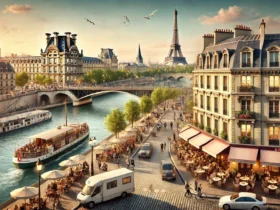Europe is a treasure trove of diverse cultures, rich history, and breathtaking landscapes. With so many cities offering unique experiences, it can be hard to decide where to go first. From the romantic streets of Paris to the architectural wonders of Barcelona, here are the best cities to travel in Europe, each promising a memorable adventure.
1. Paris, France: The City of Love and Lights
Paris, often referred to as “The City of Love,” is a top destination for travelers worldwide. With its stunning architecture, world-class museums, and delectable cuisine, Paris offers something for everyone.
Highlights of Paris:
- Eiffel Tower: The iconic symbol of Paris, offering breathtaking views of the city.
- Louvre Museum: Home to thousands of works of art, including the famous Mona Lisa and Venus de Milo.
- Notre-Dame Cathedral: A masterpiece of Gothic architecture with beautiful stained glass windows.
- Montmartre: A charming neighborhood known for its artistic history, cafes, and the stunning Sacré-Cœur Basilica.
- Seine River Cruise: A relaxing way to see the city’s landmarks illuminated at night.
Tips for Visiting Paris:
- Buy tickets in advance for popular attractions to skip the lines.
- Explore the city on foot or by using the extensive metro system.
- Enjoy a picnic at one of the many parks, such as Luxembourg Gardens or Champ de Mars.
2. Rome, Italy: The Eternal City
Rome is a city that combines ancient history with a modern, vibrant atmosphere. Known for its historic ruins, stunning churches, and delicious Italian cuisine, Rome offers a unique travel experience.
Highlights of Rome:
- Colosseum: The ancient amphitheater that hosted gladiator battles and public spectacles.
- Vatican City: The world’s smallest independent state, home to St. Peter’s Basilica, the Sistine Chapel, and the Vatican Museums.
- Trevi Fountain: A Baroque masterpiece where visitors toss coins to ensure a return trip to Rome.
- Roman Forum: The center of ancient Roman life, with ruins of temples, marketplaces, and government buildings.
- Piazza Navona: A lively square featuring beautiful fountains, street performers, and cafes.
Tips for Visiting Rome:
- Wear comfortable shoes; Rome’s cobblestone streets can be tough on your feet.
- Plan your visit to the Vatican early in the morning to avoid the crowds.
- Enjoy authentic Italian cuisine in the Trastevere neighborhood, away from the tourist areas.
3. Barcelona, Spain: A City of Art and Architecture
Barcelona is a vibrant city known for its unique blend of modernist and Gothic architecture, lively beaches, and delicious tapas. With its sunny weather and friendly locals, Barcelona is a perfect destination for travelers seeking both culture and relaxation.
Highlights of Barcelona:
- La Sagrada Familia: Antoni Gaudí’s unfinished basilica, a UNESCO World Heritage Site and a must-see for architecture enthusiasts.
- Park Güell: A colorful public park designed by Gaudí, featuring whimsical sculptures and mosaics.
- La Rambla: A bustling street lined with shops, cafes, and street performers, perfect for a leisurely stroll.
- Gothic Quarter: A maze of narrow medieval streets filled with history, shops, and tapas bars.
- Barceloneta Beach: A popular urban beach, perfect for sunbathing, swimming, or enjoying a seaside meal.
Tips for Visiting Barcelona:
- Book tickets online for La Sagrada Familia and Park Güell to avoid long waits.
- Be cautious of pickpockets, especially in crowded areas like La Rambla.
- Explore the city’s markets, such as La Boqueria, for fresh produce and local delicacies.
4. Amsterdam, Netherlands: A City of Canals and Culture
Amsterdam is a picturesque city known for its charming canals, historic buildings, and world-renowned museums. It offers a relaxed atmosphere perfect for leisurely exploring by foot, bike, or boat.
Highlights of Amsterdam:
- Rijksmuseum: The national museum of the Netherlands, home to masterpieces by Rembrandt, Vermeer, and Van Gogh.
- Anne Frank House: The historic home where Anne Frank wrote her diary during World War II.
- Van Gogh Museum: Features the world’s largest collection of works by Vincent van Gogh.
- Jordaan District: A trendy neighborhood with narrow streets, unique boutiques, and cozy cafes.
- Canal Cruise: A must-do to experience the beauty of Amsterdam’s waterways.
Tips for Visiting Amsterdam:
- Rent a bike to explore the city like a local; Amsterdam is very bike-friendly.
- Purchase tickets in advance for popular attractions, especially the Anne Frank House.
- Enjoy local delicacies like stroopwafels, herring, and Dutch cheese at street markets.
5. Prague, Czech Republic: A Fairy-Tale City
Prague, with its stunning Gothic architecture, cobblestone streets, and fairytale-like charm, is one of Europe’s most beautiful cities. It offers a mix of historical landmarks and vibrant cultural scenes.
Highlights of Prague:
- Prague Castle: The largest ancient castle complex in the world, offering panoramic views of the city.
- Charles Bridge: A historic stone bridge adorned with statues, perfect for a romantic stroll.
- Old Town Square: Features colorful baroque buildings, the Astronomical Clock, and lively street performers.
- St. Vitus Cathedral: A Gothic masterpiece located within the Prague Castle complex.
- Jewish Quarter (Josefov): Home to historic synagogues, museums, and the Old Jewish Cemetery.
Tips for Visiting Prague:
- Visit early in the morning or late in the evening to avoid crowds at popular sites.
- Use public transportation; the metro and trams are efficient and easy to navigate.
- Try local dishes such as goulash, trdelník (a sweet pastry), and Czech beer.
6. Vienna, Austria: The City of Music and Elegance
Vienna is a city of imperial grandeur, known for its historic palaces, classical music heritage, and rich coffeehouse culture. It is a destination that combines elegance, history, and cultural sophistication.
Highlights of Vienna:
- Schönbrunn Palace: The former summer residence of the Habsburg monarchs, with stunning gardens and a zoo.
- St. Stephen’s Cathedral: A Gothic cathedral in the city center, known for its ornate roof and tall spires.
- Belvedere Palace: A baroque masterpiece housing an extensive art collection, including works by Gustav Klimt.
- Vienna State Opera: A world-renowned opera house offering performances of classical music, ballet, and opera.
- Naschmarkt: Vienna’s most popular market, offering a variety of foods, spices, and antiques.
Tips for Visiting Vienna:
- Consider purchasing a Vienna Pass for access to many attractions and public transportation.
- Attend a classical music concert or opera to experience Vienna’s musical heritage.
- Enjoy a coffee and Sachertorte (chocolate cake) at one of the city’s historic cafes.
7. Lisbon, Portugal: A City of Hills and History
Lisbon is a city of colorful streets, historic trams, and stunning views from its many hills. It offers a mix of historic landmarks, vibrant neighborhoods, and delicious cuisine, making it a must-visit destination in Europe.
Highlights of Lisbon:
- Belém Tower: A 16th-century fortress and UNESCO World Heritage Site located along the Tagus River.
- Jerónimos Monastery: A stunning example of Manueline architecture, housing the tomb of Vasco da Gama.
- Alfama District: The oldest neighborhood in Lisbon, known for its narrow streets, fado music, and Moorish architecture.
- LX Factory: A trendy area with hip cafes, shops, and street art.
- Tram 28: A vintage tram that takes you on a scenic ride through the city’s most historic areas.
Tips for Visiting Lisbon:
- Wear comfortable shoes; Lisbon is known for its steep hills and cobblestone streets.
- Take a day trip to nearby Sintra to explore its fairytale palaces and gardens.
- Try local specialties such as pastéis de nata (custard tarts) and bacalhau (salted cod).
8. Budapest, Hungary: The Pearl of the Danube
Budapest, the capital of Hungary, is a city of thermal baths, stunning architecture, and a vibrant nightlife. Split by the Danube River, it offers a unique blend of historic charm and modern energy.
Highlights of Budapest:
- Buda Castle: A historic palace complex with museums, offering panoramic views of the city.
- Fisherman’s Bastion: A neo-Gothic terrace with fairy-tale towers, overlooking the Danube and Parliament.
- Széchenyi Thermal Bath: One of the largest and most famous thermal baths in Europe, perfect for relaxation.
- Hungarian Parliament Building: A stunning example of neo-Gothic architecture, located on the banks of the Danube.
- Ruin Bars: Unique bars set in abandoned buildings, offering a quirky nightlife experience.
Tips for Visiting Budapest:
- Explore both Buda and Pest sides of the city to get a full experience.
- Enjoy a cruise on the Danube River to see the city’s illuminated landmarks at night.
- Take advantage of Budapest’s affordable prices compared to other European capitals.
9. Copenhagen, Denmark: A Blend of Modernity and Tradition
Copenhagen, the capital of Denmark, is a city that combines modern design with historic charm. Known for its bike-friendly streets, cozy cafes, and stunning waterfronts, Copenhagen is a delightful destination for travelers.
Highlights of Copenhagen:
- Nyhavn: A picturesque waterfront with colorful buildings, historic ships, and numerous cafes.
- Tivoli Gardens: One of the world’s oldest amusement parks, offering rides, gardens, and entertainment.
- The Little Mermaid Statue: A famous sculpture inspired by Hans Christian Andersen’s fairy tale.
- Rosenborg Castle: A historic castle housing the Danish crown jewels and a beautiful garden.
- Freetown Christiania: A unique, self-proclaimed autonomous neighborhood known for its artistic and bohemian vibe.
Tips for Visiting Copenhagen:
- Rent a bike to explore the city like a local; Copenhagen is one of the most bike-friendly cities in the world.
- Visit Tivoli Gardens in the evening for magical lights and live entertainment.
- Try traditional Danish pastries, smørrebrød (open-faced sandwiches), and local craft beers.
Frequently Asked Questions (FAQs)
1. What is the best time to visit Europe?
The best time to visit Europe is during the spring (April to June) or fall (September to October) when the weather is mild, and the crowds are smaller. Summer is also popular but can be crowded and expensive.
2. Do I need a visa to travel in Europe?
Visa requirements depend on your nationality. Many countries have agreements that allow visa-free travel for a limited period. Check the visa requirements for each country you plan to visit before your trip.
3. How can I travel between European cities?
Europe has an extensive transportation network, including trains, buses, and flights. High-speed trains like the Eurostar, Thalys, and ICE offer efficient travel between major cities. Budget airlines and intercity buses are also popular options.
4. What are some budget-friendly cities to visit in Europe?
Cities like Budapest, Prague, Lisbon, and Krakow are known for being budget-friendly while offering rich cultural experiences. These cities often have lower accommodation and dining costs compared to Western European capitals.
5. What should I pack for a trip to Europe?
Pack versatile clothing suitable for the weather, comfortable walking shoes, a travel adapter, and any necessary travel documents. Depending on your itinerary, consider packing layers, especially for cities with varying climates.
6. How safe is it to travel in Europe?
Europe is generally considered safe for travelers, but it’s always important to stay vigilant, especially in crowded tourist areas. Keep an eye on your belongings and be aware of common scams.
Europe is a continent full of fascinating cities, each offering unique experiences and endless opportunities for adventure. Whether you’re interested in history, art, cuisine, or simply exploring new cultures, there’s a European city waiting for you to discover it. Bon voyage!






Leave a Reply